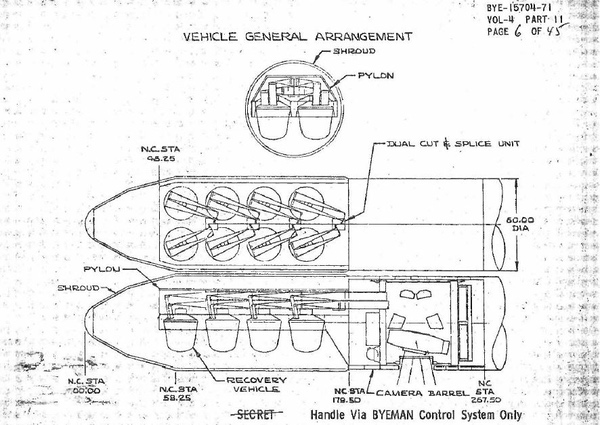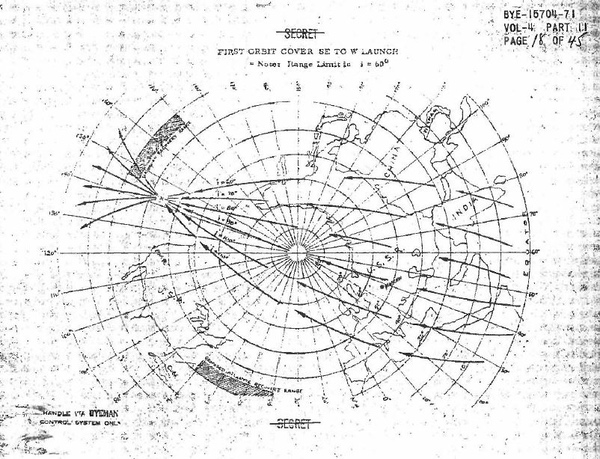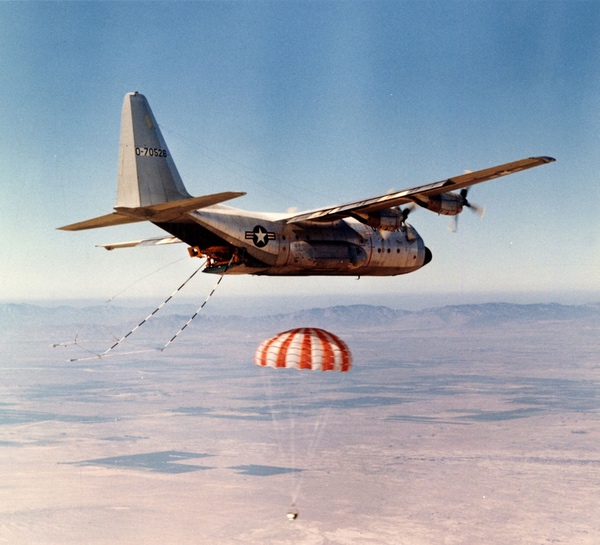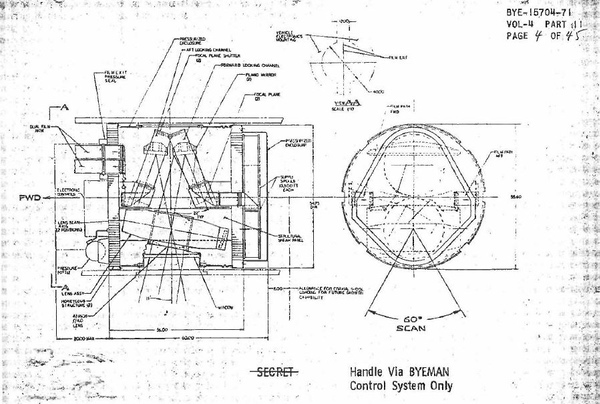National Reconnaissance Program crisis photography concepts, part 2: PINTOby Joseph T. Page II
|
| Mirroring the hardware recycling within the Corona Six-Pack system, this concept—named PINTO due to its low cost and simplicity—reused available hardware to the fullest extent. |
On January 27, 1971, the National Reconnaissance Program (NRP) Executive Committee held a meeting at the Pentagon to discuss conceptual adjuncts or alternatives to the development of an Electro-Optical Imaging (EOI) system. The concepts discussed included both National Reconnaissance Office (NRO) funded conceptual studies (Film Read-Out Gambit, SPIN SCAN) and independently developed contractor ideas (PINTO, FASTBACK, AXUMITE) to bridge the capability gap between Corona and Gambit film-based satellites and the next generation digital (EOI) satellite program.
As described in the previous article (see “National Reconnaissance Program crisis photography concepts, part 1: A six-pack of Corona”, The Space Review, May 31, 2022), the pressing need for reconnaissance during crisis situations was revealed through a handful of incidents during the decade of the 1960s. The previously described “Corona Six-Pack” concept reused then-available photographic hardware (J-3 camera), upper stages (Agena), and booster rockets (Atlas-F) in a chimera design, keeping original hardware unchanged to lessen the burden on established NRP processes (launch, commanding, recovery) while meeting specific crisis requirements and timelines.
Driving the risk down
Mirroring the hardware recycling within the Corona Six-Pack system, this concept—named PINTO due to its low cost and simplicity—reused available hardware to the fullest extent, lessening acquisition uncertainties and operational risk.[1] PINTO’s stated benefits included responsiveness to rapidly occurring crisis situations, reliability obtained from flight-proven hardware, relatively low cost (as compared to other NRP projects), and availability within two years of project approval.
The center of the PINTO concept was the 48-inch (122-centimeter) focal length panoramic stereo camera modified from the Fairchild Camera and Instrument Corporation’s versatile KA-81 Long Focal Length Panoramic Reconnaissance (aircraft) Camera system—complete with automatic focus adjustment—providing an average two-foot (60-centimeter) ground resolved distance (GRD) resolution.[2] Eight re-entry vehicles (RVs), roughly two-thirds the size of the stalwart Mark V RVs, would bring back the Eastman-Kodak 3414 film spools containing approximately 1300 feet (400 meters) of images in each capsule.
 PINTO re-entry vehicle arrangement (courtesy of the NRO) |
The proposed PINTO upper stage used a Corona-configured Agena D with the addition of the Gambit dual attitude control system and secondary propulsion systems. Other changes, such as increased control gas volume and extension of programming from 20 to 30 days allowed for extended on-orbit mission timelines. The weight of the system—less than 5,800 pounds (2,630 kilograms)—allowed for launch inclination angles ranging from 60 to 110 degrees, giving the system flexibility in reaching a variety of target locations within the first few orbital revolutions. Timing of the launch also affected the target area’s illumination by sunlight. With launches near midnight Pacific Standard Time, locations could be imaged during the first few orbits, and capsule retrieval on revolution 9, 10, or 11.
 Target coverage for PINTO’s first orbital revolution (courtesy of the NRO) |
Within the NRP crisis management proposals, the ability to reach the Suez Canal was the measurement benchmark. For PINTO, the Suez Canal could be covered within revolutions 1 through 3, at inclinations varying from 100 to 62 degrees (respectively), allowing for a rapid return of data in subsequent revolutions over the Pacific Ocean recovery zone. Time of day also affected recovery operations, with night launches (2100 through 0100 PST) giving an earlier retrieval time (by nearly 12 hours) over a day launch window.
Catching falling stars
The desire for rapid retrieval of photographic film during crisis situations had the PINTO proposal team investigate the feasibility of an Atlantic Ocean recovery. Getting the imagery back to national leaders in Washington was of primary importance but also provided critical limiting factors. The Air Force Satellite Control Facility (AFSCF) at Sunnyvale Air Force Station, California pulled split duty within the NRP: first controlling the satellites in space, and then directing the recovery efforts of returning film capsules. The AFSCF’s recovery force, the 6594th Test Group, was headquartered at Hickam AFB in Hawaii during the Corona, Gambit, and Hexagon programs (1959–1986).
 A JC-130B practices catching a re-entry vehicle over Edwards Air Force Base in 1969 (courtesy of the United States Air Force) |
Creation of an Atlantic recovery force would require an additional fleet of seven specially modified JC-130 aircraft located “somewhere” on the East Coast. Meteorological conditions were much worse in the Atlantic, as a spawning area of hurricanes coupled with the frequency of frontal activities. The proposed Atlantic Recovery Zone imagined an area from Puerto Rico to Bermuda, with 25-degrees of latitude over the East-West direction.
| The PINTO satellite system was outpaced by better photographic satellite systems about to leave the barn. |
Transit time from the zone to the film-processing facility in the Washington DC area was estimated around four hours. In comparison, only one hour would elapse between a Pacific Ocean aerial RV retrieval to processing at Hawaii’s Overseas Processing and Interpretation Center-Asia (OPIC-A).[4] The net savings time with the Atlantic recovery was only three hours, and not deemed an acceptable course of action with the cost of maintaining a second recovery force and other added risks.
Reining in PINTO until necessary
Implied in the definition of “crisis,” necessary PINTO launch timelines were unknown; however, the ability of the Agena hardware and Atlas booster to remain in readiness status was notable. Factors affecting a 90-day pad hold included:
- No propellant was loaded until start of countdown (ranging from eight to two hours prior)
- Agena and camera environmental controls
- Hardware “health” status checks
- Battery recharging
- Dry countdowns every 30 days
After the expiration of the 90-day hold, major subsystems would require reloading, such as the camera, or replacement of batteries and pyrotechnics. A system-wide recalibration and revalidation was necessary before being placed on another 90-day hold period.
Comparisons to the Big Bird
PINTO’s proposal included comparisons against the KH-9 Hexagon system, since the proposal was written around the time of Hexagon’s first flight on June 15, 1971:
“PINTO has resolution as good as HEXAGON, but its capacity is much smaller… [PINTO’s] rapid response and low cost make it an ideal ‘junior partner for HEXAGON.”
The proposal expands on the Hexagon alternative, in cases of launch delays due to hardware issues, on- orbit failures, or high priority requirements between KH-9 missions.
End of the Race
Mining the horse analogy, the PINTO satellite system was outpaced by better photographic satellite systems about to leave the barn: Hexagon and the aforementioned EOI system (later renamed Kennen). Just like its “Six-Pack” sister design, PINTO’s arrival came too late in the programmatic timelines within the Corona program, requiring a restart to manufacturing hardware. While the Fairchild KA-81 camera would remain on the assembly line for use within other reconnaissance programs (such as BIG SAFARI C-97 aircraft), similar issues with Agena upper stage scheduling and prioritization with Atlas-E/F boosters, as well as EOI development would explode the PINTO concept before it ever left the drawing board.
The next two crisis management concepts in this series – AXUMITE and FASTBACK – would revolutionize the ideas behind hardware reuse within the NRP, by using distinct launch vehicles (F-4 Phantom II aircraft and the LGM-30 Minuteman ICBM, respectively) from United States Air Force tactical and strategic forces.
Endnotes
- No Author. “Volume 4, Part II: PINTO.” BYE-15704-71. Document C05137580, approved by NRO for release on 29 March 2022.
- Little information has been found on the internet detailing specification for the KA-81 panoramic camera, aside from brief mentions of the camera’s incorporation into the Air Force’s BIG SAFARI reconnaissance program and Fairchild product brochures.
- While undetermined via records review, it is extremely likely that Fairchild’s concept was named after the low-cost and simplicity of the Ford Motor Company’s Pinto car, since the stated characteristics cannot be measured in the animal version. At the time of the concept’s creation (1971), the Ford Pinto’s abysmal safety record had not yet been discovered by American consumers. Though if the design had gone forth, it is likely the satellite system would have earned a renaming by anyone with any active braincells.
- On August 18, 1967, the 67th Reconnaissance Technical Squadron at Yokota AB, Japan was recertified as the Overseas Processing and Interpretation Center – Asia (OPIC-A). This change allowed theater commanders priority in processing and viewing imagery from reconnaissance systems such as SR-71 and U-2. At some unknown point, OPIC-A moved to Hawaii.
Note: we are using a new commenting system, which may require you to create a new account.
